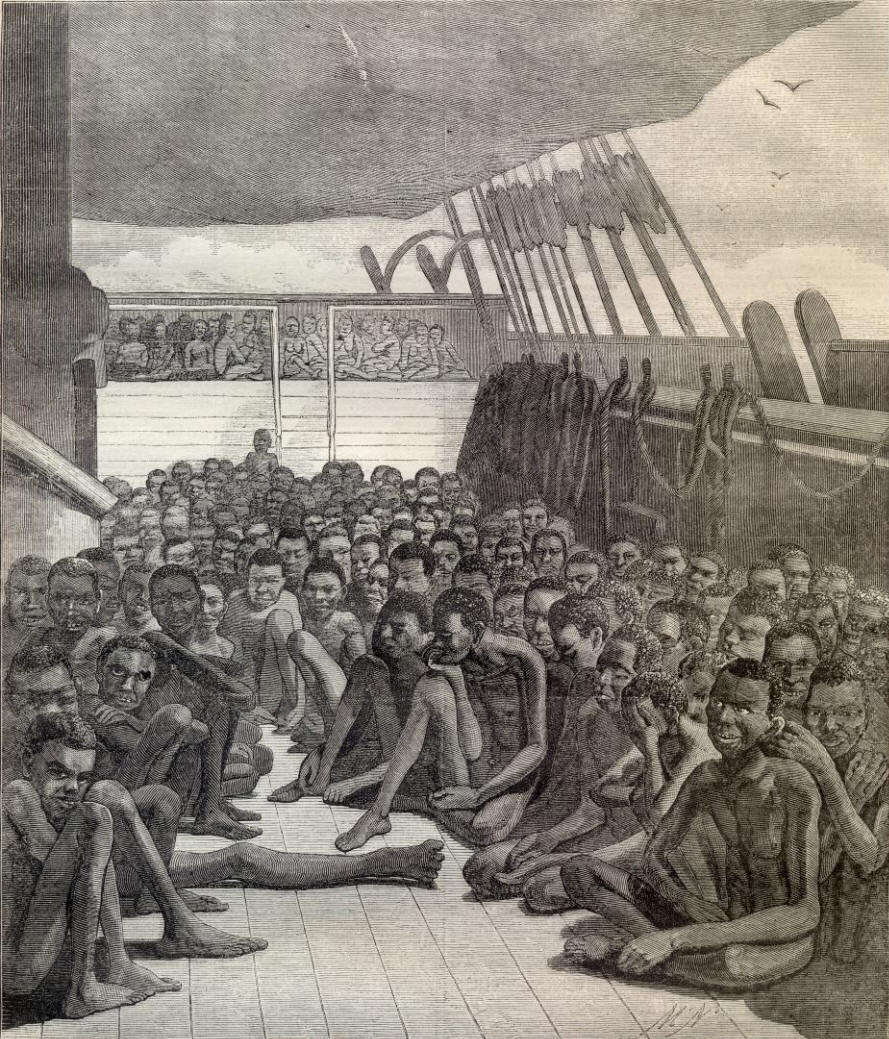African Slave Ship
![]()
This Site:
HARPER'S WEEKLY.
[JUNE 2, 1860.
344
THE AFRICANS OF THE SLAVE BARK "WILDFIRE,"--[FROM OUR OWN CORRESPONDENT.]
THE SLAVE DECK OF THE BARK "WILDFIRE," BROUGHT INTO KEY WEST ON APRIL 30, 1860,-[FROM A DAGUERREOTYPE.]
KEY WEST, FLORIDA, May 20, 1860.
ON the morning of the 30th of April last, the United States steamer Mohawk, Lieutenant Craven commanding, came to anchor in the harbor of this place, having in tow a bark of the burden of about three hundred and thirty tons, supposed to be the bark Wildfire, lately owned in the city of New York. The bark had on board five hundred and ten native Africans, taken on board in the River Congo, on the west side of the continent of Africa. She had been captured a few days previously by Lieutenant Craven within sight of the northern coast of Cuba, as an American vessel employed in violating our laws against the slave-trade. She had left the Congo River thirty-six days before her capture.
Soon after the bark was anchored we repaired on board, and on passing over the side saw, on the deck of the vessel, about four hundred and fifty native Africans, in a state of entire nudity, in a sitting or squatting posture, the most of them having their knees elevated so as to form a resting,
place for their heads and arms. They sat very close together, mostly on either side of the vessel, forward and aft, leaving a narrow open space along the line of the centre for the crew of the vessel to pass to and fro. About fifty of them were full-grown young men, and about four hundred were boys aged from ten to sixteen years. It is said by persons acquainted with the slave-trade and who saw them, that they were generally in a very good condition of health and flesh, as compared with other similar cargoes, owing to the fact that they had not been so much crowded together on board as is common in slave voyages, and had been better fed than usual. It is said that the bark is capable of carrying, and was prepared to carry, one thousand, but not being able without inconvenient delay to procure so many, she sailed with six hundred. Ninety and upward had died on the voyage. But this is considered as comparatively a small loss, showing that they had been better cared for than usual. Ten more have died since their arrival, and there are about forty more sick in the hospital. We saw
on board about six or seven boys and men greatly emaciated, and diseased past recovery, and about a hundred that showed decided evidences of suffering from inanition, exhaustion, and disease. Dysentery was the principal disease. But notwithstanding their sufferings, we could not be otherwise than interested and amused at their strange looks, motions, and actions. The well ones looked happy and contented, and were ready at any moment to join in a song or a dance whenever they were directed to do so by "Jack"—a little fellow as black as ebony, about twelve years old, having a handsome and expressive face, an intelligent look, and a sparkling eye. The sailors on the voyage had dressed "Jack" in sailor costume, and had made him a great pet. When we were on board "Jack" carried about in his hand a short cord, not only as the emblem but also as the instrument of his brief delegated authority. He would make the men and boys stand up, sit down, sing, or dance just as he directed. When they sang " Jack" moved around among them as light as a cat, and beat the time by
slapping his hands together, and if any refused to sing, or sang out of time, Jack's cord descended on their backs. Their singing was monotonous. The words we did not understand. We have rarely seen a more happy and merry-looking fellow than " Jack."
From the deck we descended into the cabin, where we saw sixty or seventy women and young girls, in Nature's dress, some silting on the floor and others on the lockers, and some sick ones lying in the berths. Four or five of them were a good deal tattooed on the back and arms, and we noticed that three had an arm branded with the figure " 7," which, we suppose, is the merchant's mark.
On the day of their arrival the sickest, about forty in all, were landed and carried to a building-on the public grounds belonging to Fort Taylor, and Doctors Whitehurst and Shrine employed as medical attendants. We visited them in the afternoon. The United States Marshal had procured for all of them shirts, and pants for the men, and some benevolent ladies of the city had sent the (Next Page)

![]()
|
Email us at: paul@sonofthesouth.net. Copyright © 2003-2018 Son of the South.
|
|
|
|
Are you Scared and Confused? Click Here to read My Snake Story, a story of hope and encouragement, to help you face your fears. |
||